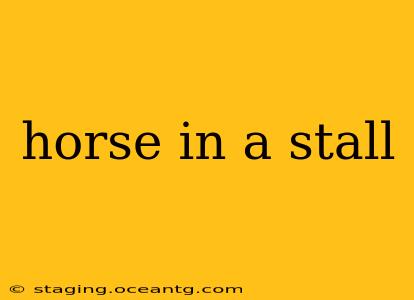Keeping a horse in a stall is a significant responsibility. It requires understanding their natural behaviors, needs, and potential issues to ensure their well-being and happiness. This guide delves into various aspects of stall life for equines, addressing common questions and concerns.
What is the best bedding for a horse stall?
Choosing the right bedding is crucial for maintaining a clean, dry, and comfortable environment for your horse. Several options exist, each with pros and cons:
-
Straw: A traditional and readily available option, straw is absorbent but can be dusty and less economical in the long run due to higher consumption. It's also more prone to mold if not managed properly.
-
Wood shavings: These offer excellent absorbency, are relatively dust-free (depending on the type of wood), and are generally more economical than straw. However, some horses may consume shavings, leading to digestive issues. Pine and cedar shavings should be avoided, as the oils can be harmful.
-
Flax: An increasingly popular choice, flax offers excellent absorbency, is relatively dust-free, and is more comfortable for horses to lie on. It's more expensive than straw or shavings, but often requires less frequent changing.
-
Paper bedding: Made from recycled paper, this is a highly absorbent and dust-free option. It’s environmentally friendly but can be more expensive than traditional choices.
The best bedding for your horse will depend on factors such as your budget, climate, and your horse's individual needs and preferences. Always prioritize a clean and dry environment.
How much space does a horse need in a stall?
The ideal stall size depends on the horse's size and breed, but generally, a minimum of 10 x 12 feet is recommended. Larger horses naturally require more space. Overcrowding can lead to stress, injury, and behavioral problems. Consider factors like the horse's temperament and activity level when determining appropriate stall size. A more active horse may benefit from a larger stall.
How often should I clean a horse stall?
Regular stall cleaning is vital for maintaining hygiene and preventing health issues. Ideally, stalls should be mucked out (removing manure and wet bedding) at least once daily, with a complete bedding change every few days or as needed, depending on the bedding type and the horse's habits. Failure to clean stalls regularly can lead to the build-up of ammonia, which can irritate your horse's respiratory system. This is particularly important for horses with respiratory sensitivities.
What are signs of a sick horse in a stall?
Recognizing the signs of illness is crucial for promptly addressing any health concerns. Key indicators include:
-
Lethargy or depression: A lack of energy, decreased appetite, and withdrawal are all potential signs of illness.
-
Changes in respiration: Increased breathing rate, coughing, or nasal discharge should be monitored closely.
-
Changes in appetite or water intake: Significant increases or decreases can indicate underlying problems.
-
Fever: Elevated body temperature is a common symptom of various illnesses.
-
Lameness or stiffness: Difficulty moving or apparent pain in any part of the body.
-
Changes in feces or urine: Changes in consistency, color, or frequency can indicate a digestive or urinary tract issue.
If you notice any of these signs, contact your veterinarian immediately.
What are common horse stall behaviors?
Horses exhibit various behaviors in their stalls, some of which are natural, and others may indicate underlying issues. Understanding these behaviors is vital for addressing potential problems and ensuring your horse's well-being:
-
Pawing: This can be a sign of boredom, frustration, or discomfort. Providing appropriate enrichment can help reduce pawing.
-
Cribbing: This involves grasping objects with the teeth and sucking in air, often associated with stress or gastric issues. Specialized cribbing collars might be necessary to mitigate this.
-
Weaving: Repetitive swaying back and forth can be a sign of stress, anxiety, or confinement. This requires careful observation and management to provide a more stimulating environment.
Careful observation of your horse's behavior is crucial for early identification of any underlying health issues or environmental stressors.
By understanding your horse's needs and carefully managing their stall environment, you can ensure a happy and healthy equine companion. Remember to always consult with your veterinarian for any health concerns.
